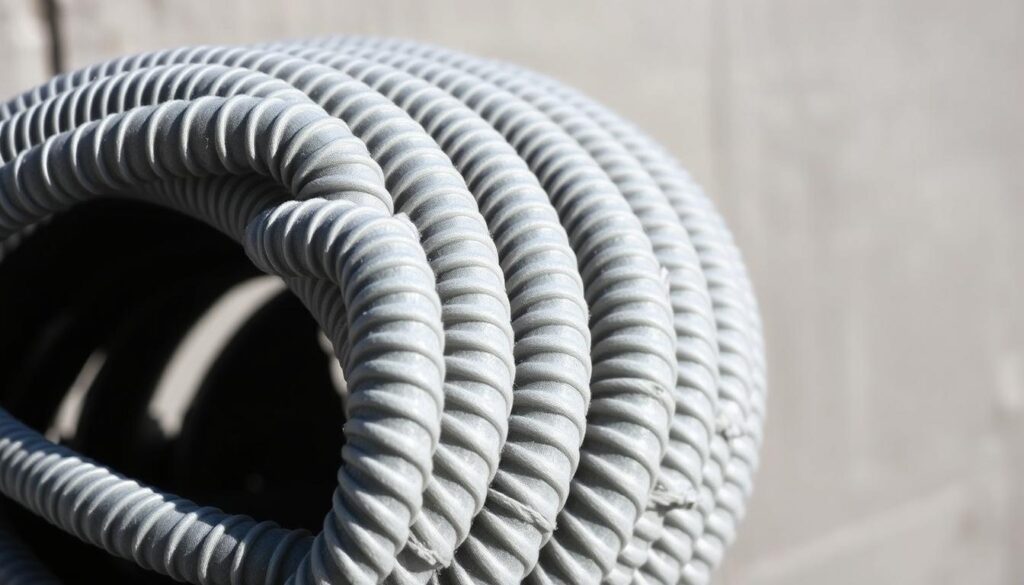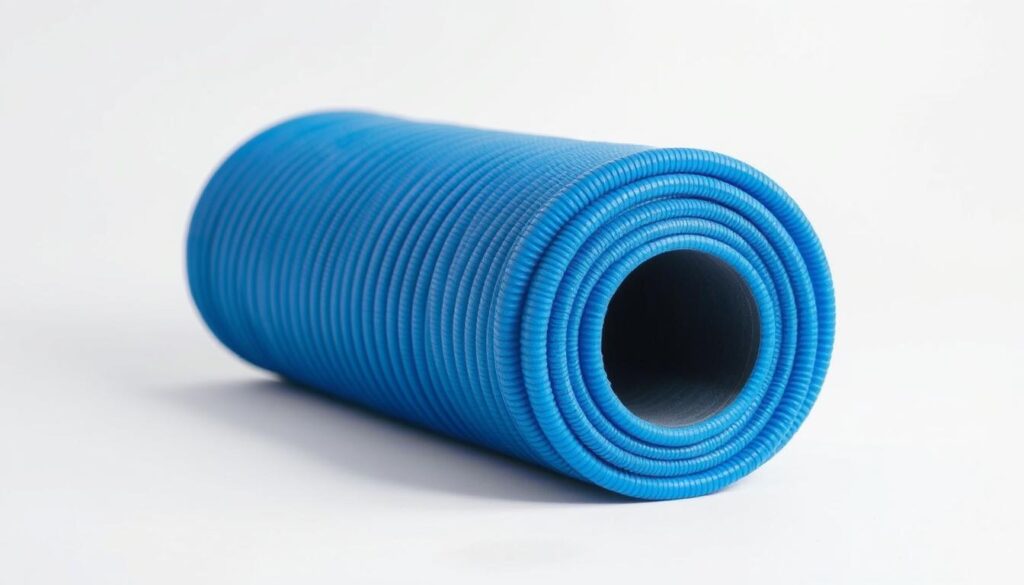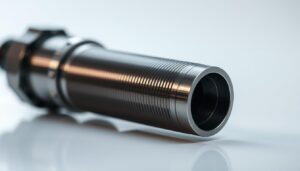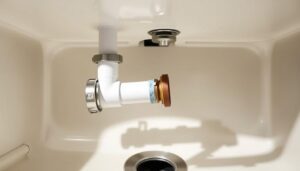As the temperatures drop, UK homeowners face the risk of frozen and burst pipes, leading to costly repairs and extensive water damage. Properly insulating your pipes is a proven way to boost your building’s energy efficiency and prevent such disasters.
Effective pipe insulation serves as a protective barrier against freezing temperatures, safeguarding your plumbing from temperature extremes. By taking proactive measures, you can ensure your pipe insulation is up to the task and enjoy a worry-free winter.
Key Takeaways
- Insulating pipes is crucial for preventing costly damage from burst pipes.
- Proper pipe insulation boosts energy efficiency and protects against temperature extremes.
- Selecting the right insulation materials is vital for effective pipe protection.
- Implementing effective installation techniques ensures optimal performance.
- Understanding the different types of pipe insulation helps you make an informed decision.
Why Insulating Outdoor Water Pipes is Essential
Freezing temperatures can cause significant damage to uninsulated outdoor pipes, making pipe insulation a necessity. When temperatures drop below zero, uninsulated pipes are highly susceptible to freezing, which can lead to pipe bursts and potentially thousands of pounds in water damage repairs.

Preventing Costly Freeze Damage
Proper insulation creates a thermal barrier that reduces heat loss from hot water pipes, maintaining water temperature for longer periods and significantly improving your home’s energy efficiency. This not only prevents costly freeze damage but also ensures that your plumbing system operates effectively throughout the year.
Energy Efficiency Benefits
By reducing the energy needed to reheat water that has cooled in uninsulated pipes, you’ll notice a measurable reduction in your energy bills throughout the year. Effective pipe insulation helps maintain the temperature of the fluids flowing in the system, improving overall performance and reducing expenses for system maintenance and repairs.
Environmental Impact and Sustainability
The environmental benefits of proper insulation include reduced energy consumption and lower carbon emissions, contributing to a more sustainable home and helping meet the UK’s climate goals. By choosing the right pipe insulation, you can significantly reduce heat loss and enhance your home’s energy efficiency, making it a crucial step towards a more sustainable future.
Understanding Different Types of Pipe Insulation Materials
To protect outdoor water pipes effectively, it’s essential to understand the characteristics of various pipe insulation materials. The right insulation material can significantly enhance the durability and performance of your pipes.
Foam Insulation Options
Foam insulation is a popular choice for outdoor water pipes due to its ease of installation and cost-effectiveness. Polyethylene foam and elastomeric foam are two commonly used types.
Polyethylene Foam
Polyethylene foam is a rigid or flexible plastic foam that provides good thermal resistance at an affordable prices. It is suitable for standard applications but has a limited temperature range.
Elastomeric Foam
Elastomeric foam is a flexible, cellular rubber insulation that offers superior moisture resistance and is easy to install. It is ideal for outdoor applications where pipes are exposed to the elements.
Rubber-Based Insulation Products
Rubber-based insulation products, such as nitrile rubber, provide exceptional durability and UV resistance. They are suitable for outdoor applications and offer excellent protection against freezing temperatures and solar degradation.
Fiberglass and Mineral Wool Options
Fiberglass and mineral wool insulation deliver high-temperature resistance and are often used with a protective outer covering for outdoor applications. While they provide excellent thermal performance, they require additional waterproofing.
Comparing Insulation R-Values and Thickness Requirements
The thickness of pipe insulation is critical to its effectiveness. Thicker insulation generally provides higher R-values and better protection against extreme temperatures. When comparing different pipe lagging materials, consider factors such as initial cost, longevity, ease of installation, and performance in specific environmental conditions.
How to Insulate Outdoor Water Pipes Effectively
To effectively insulate your outdoor water pipes, it’s crucial to understand the proper techniques and materials required for the job. The key to achieving maximum efficiency with any pipe insulation is proper installation. This involves using the appropriate thickness for the pipe size and application, ensuring that all seams and joints are thoroughly sealed to prevent gaps that enable heat transfer.
Measuring and Preparing Your Pipes
Before beginning the installation process, accurately measure your pipes to determine the correct size and quantity of insulation needed. Ensure you purchase materials with the appropriate internal diameter to fit snugly around your pipes. Proper preparation of pipes is essential for effective insulation—thoroughly clean the pipe surface to remove dirt, moisture, and any loose material that could prevent adhesive from bonding properly.
Step-by-Step Installation Guide
When installing pipe insulation, always follow manufacturer instructions regarding application techniques, as different products may have specific requirements for optimal performance. Use the recommended adhesive, sealant, or tape to secure the insulation in place. Pay special attention to valves, elbows, and hangers, which are common areas for air gaps if not insulated properly.
- Seal all seams and joints thoroughly to prevent gaps that enable heat transfer.
- Use vapor-barrier facings when required to prevent moisture issues.
- Follow manufacturer specifications for cutting, bending, and securing the insulation.
- Insulate the entire pipe length for maximal performance.
Sealing Joints and Connections Properly
Sealing joints and connections is critical to preventing cold air infiltration—use waterproof tape designed specifically for pipe insulation to secure all seams, ensuring there are no gaps where cold air can penetrate. For areas where pipes bend or connect, cut the insulation at an angle to create a tight fit, then seal these vulnerable joints with additional tape or adhesive to maintain thermal integrity.
Special Considerations for Outdoor Applications
Outdoor applications require special consideration for UV protection and weatherproofing—consider adding a protective outer layer or using insulation specifically designed for external use. Common installation mistakes include leaving gaps between insulation sections, failing to secure the insulation properly, and neglecting to insulate valves and fittings—all of which can significantly reduce effectiveness.
Top Pipe Insulation Products for UK Weather Conditions
Effective pipe insulation is vital for outdoor pipes exposed to the UK’s harsh weather conditions. You need products that can withstand freezing temperatures, rain, wind, and UV exposure.
Armacell External Use Kaiflex Pipe Insulation
Armacell External Use Kaiflex Pipe Insulation is a premium option for outdoor applications, featuring closed-cell rubber construction that provides excellent thermal performance and moisture resistance. It’s ideal for exposed pipes in harsh weather conditions.
Climaflex Polyethylene Pipe Lagging
Climaflex Polyethylene Pipe Lagging offers an affordable and widely available solution that performs well in standard UK weather conditions. It comes in various diameter options to fit different pipe sizes and has a straightforward installation process.
K-Flex Self-Seal Elastomeric Insulation
K-Flex Self-Seal Elastomeric Insulation features an integrated adhesive strip that simplifies installation while providing superior sealing properties. It eliminates the need for additional adhesives and ensures a tight, weatherproof fit.
Rockwool Foil-Faced Pipe Insulation
Rockwool Foil-Faced Pipe Insulation combines mineral wool insulation with a reflective foil outer layer, providing excellent thermal performance while adding an additional moisture barrier that enhances durability in wet conditions.
When selecting pipe lagging products for outdoor use, consider factors such as UV resistance, water resistance, and temperature range to ensure optimal performance throughout the year. The best pipe insulation products for UK weather will typically feature weatherproof outer layers or be compatible with protective coverings that shield the insulation from direct environmental exposure.
Maintenance and Protection of Insulated Outdoor Pipes
The key to protecting your outdoor pipes from freezing lies in the regular inspection and maintenance of their insulation. Conducting periodic inspections is the cornerstone of good insulation maintenance. It’s recommended to inspect your pipe insulation at least once a year or more frequently if exposed to severe environmental conditions.
Seasonal Inspection Checklist
Develop a seasonal inspection checklist that includes examining the insulation for signs of damage, deterioration, or gaps that might have developed due to weather exposure or physical impacts. Before winter arrives, conduct a thorough inspection of all outdoor pipe insulation, paying particular attention to joints, bends, and areas where pipes enter the building.

Addressing Common Issues and Damage
Common issues with pipe insulation include compression, moisture ingress, and damage from pests or physical impacts. Inspect for any areas where the insulation might have been squashed or flattened, and check for signs of moisture. For more information on suitable external pipe insulation products, you can visit our website.
Additional Protection Methods for Extreme Weather
For pipes in extremely exposed locations, consider implementing additional protection methods such as heat tape, pipe heating cables, or insulated pipe boxes. Proper maintenance extends beyond the insulation itself to include the entire system, ensuring that outdoor taps are properly drained before winter and that any leaks are promptly addressed.
Conclusion: Ensuring Long-Term Protection for Your Outdoor Pipes
Effective pipe insulation is a simple yet effective way to safeguard your outdoor pipes from freezing temperatures. By optimizing your external pipe insulation, you’re not only protecting your plumbing system but also contributing to a more sustainable future.
Throughout this guide, we’ve explored the essential aspects of pipe insulation, from understanding its necessity to selecting appropriate materials and implementing effective installation techniques. Properly insulating your outdoor water pipes represents a small investment that delivers significant returns in terms of protection against freezing, energy efficiency, and system longevity.
The energy savings achieved through proper pipe insulation contribute to both reduced utility bills and a smaller carbon footprint. As UK weather patterns become increasingly unpredictable due to climate change, investing in quality pipe insulation becomes even more important as a preventative measure against extreme temperature fluctuations. By following the recommendations in this guide, you’ll be well-equipped to protect your outdoor pipes and enhance the overall efficiency of your home.



